
Photo from wikipedia
Objectives To evaluate the impact of patient positioning during CT-guided lung biopsy on patients’ outcomes. Methods In this retrospective, IRB-approved, HIPAA-compliant study, consecutive CT-guided lung biopsies performed on 5/1/2015–12/26/2017 were… Click to show full abstract
Objectives To evaluate the impact of patient positioning during CT-guided lung biopsy on patients’ outcomes. Methods In this retrospective, IRB-approved, HIPAA-compliant study, consecutive CT-guided lung biopsies performed on 5/1/2015–12/26/2017 were included. Correlation between incidence of pneumothorax, chest tube placement, pulmonary bleeding with patient, and procedure characteristics was evaluated. Lesion-trachea-table angle (LTTA) was defined as an angle between the lesion, trachea, and horizontal line parallel to the table. Lesion above trachea has a positive LTTA. Univariate and multivariate logistic regression analysis was performed. Results A total of 423 biopsies in 409 patients (68 ± 11 years, 231/409, 56% female) were included in the study. Pneumothorax occurred in 83/423 (20%) biopsies with chest tube placed in 11/423 (3%) biopsies. Perilesional bleeding occurred in 194/423 (46%) biopsies and hemoptysis in 20/423 (5%) biopsies. Univariate analysis showed an association of pneumothorax with smaller lesions ( p = 0.05), positive LTTA ( p = 0.002), and lesions not attached to pleura ( p = 0.026) with multivariate analysis showing lesion size and LTTA to be independent risk factors. Univariate analysis showed an association of increased pulmonary bleeding with smaller lesions ( p < 0.001), no attachment to the pleura ( p < 0.001), needle throw < 16 mm ( p = 0.05), and a longer needle path ( p < 0.001). Multivariate analysis showed lesion size, a longer needle path, and lesions not attached to the pleura to be independently associated with perilesional bleeding. Risk factors for hemoptysis were longer needle path ( p = 0.002), no attachment to the pleura ( p = 0.03), and female sex ( p = 0.04). Conclusions Interventional radiologists can reduce the pneumothorax risk during the CT-guided biopsy by positioning the biopsy site below the trachea. Key Points • Positioning patient with lesion to be below the trachea for the CT-guided lung biopsy results in lower rate of pneumothorax, as compared with the lesion above the trachea. • Positioning patient with lesion to be below the trachea for the CT-guided lung biopsy does not affect rate of procedure-associated pulmonary hemorrhage or hemoptysis.
Journal Title: European Radiology
Year Published: 2020
Link to full text (if available)
Share on Social Media: Sign Up to like & get
recommendations!